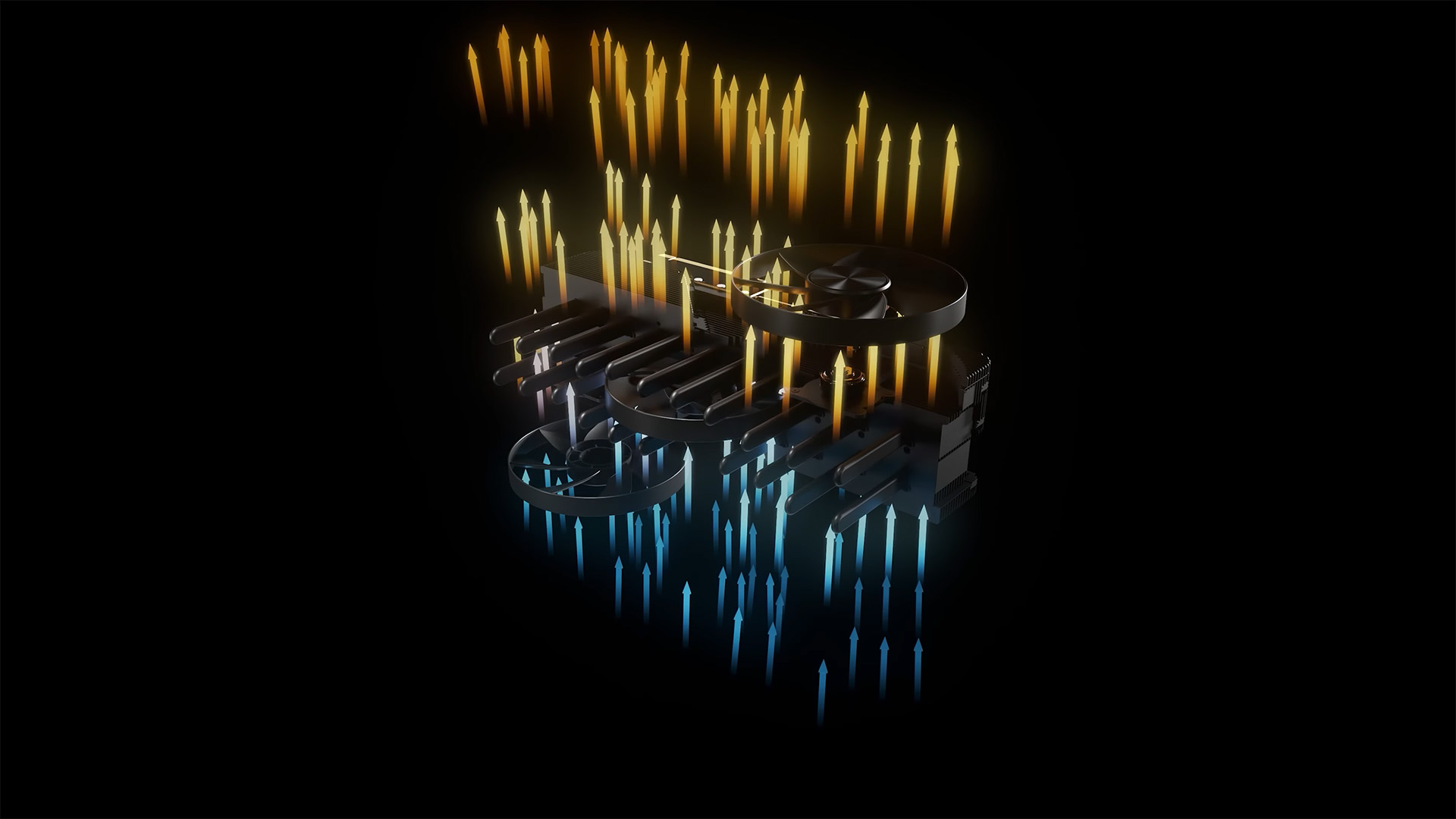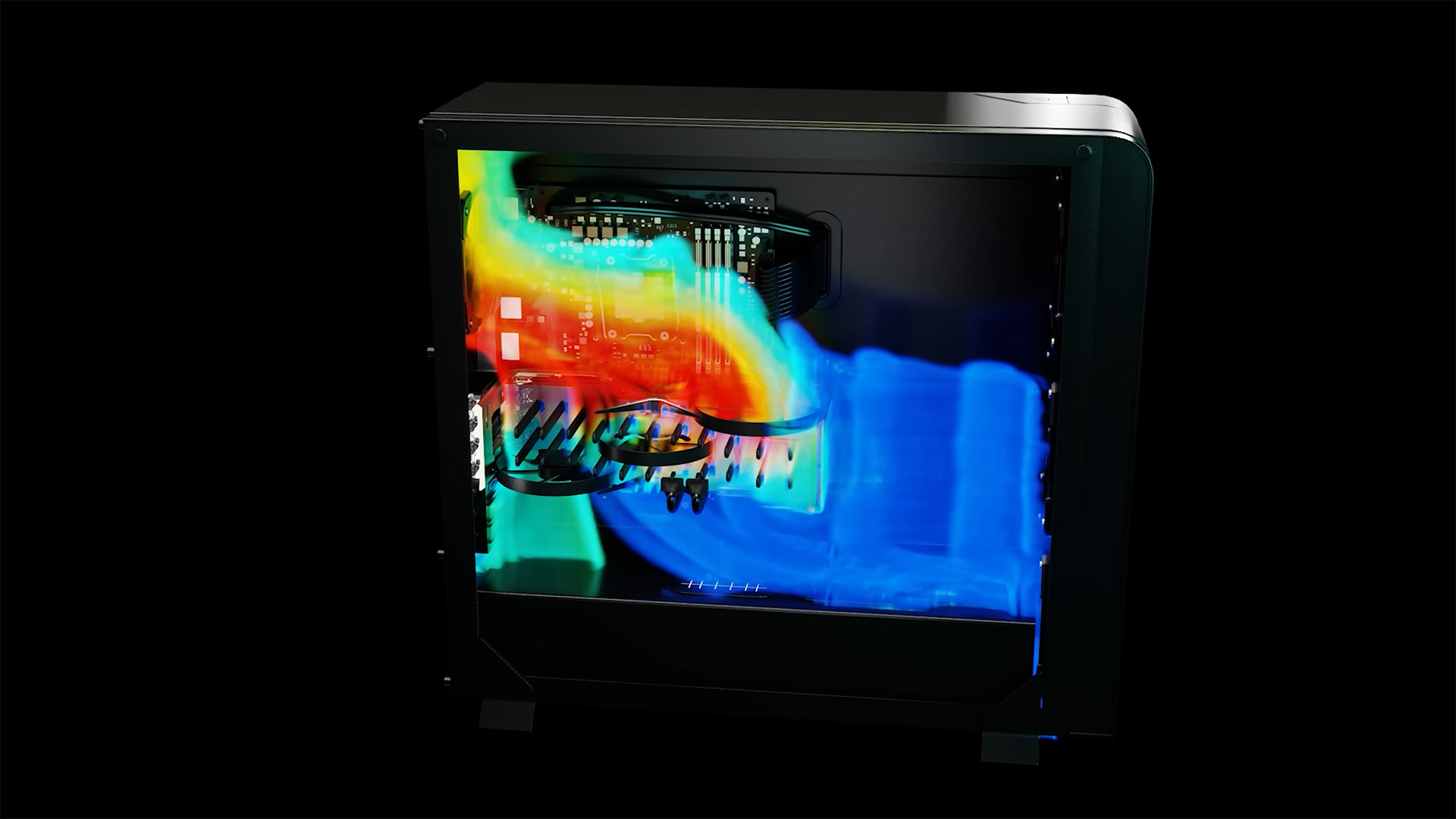Nvidia shows off gigantic quad-slot RTX 5090 FE cooler prototype in new video
Don't worry, the actual RTX 5090 FE has been slimmed down to a manageable dual-slot design.

Nvidia has published a behind the scenes video showing off the inception of the RTX 5090 Founders Edition graphics card. Half way through the video, the team revealed the prototype: a massive, quad-slot, fully flow-through graphics card featuring a vertical PCB, which was the precursor to the skinny, dual-slot 5090 FE card we have today.
This prototype Founders Edition cooler was part of Nvidia's experimentation with flow-through GPU designs. The company successfully created its first flow-through cooling architecture in the RTX 30-series Founder Edition graphics cards, and apparently decided to build on this concept by creating what it's dubbed a "three thirds flow through" cooler design.
This is the same cooler Gamers Nexus recently covered, unofficially calling it the RTX 4090 Ti and/or RTX Titan Ada GPU cooler. The defining trait of this cooler is its quadruple PCIe slot form factor, which, had it been released, would have made it the largest Founders Edition graphics card ever. The cooler was so thick that Nvidia mounted it vertically, giving a flow-through design to the entire heatsink.
Nvidia's 3D renderings reveal that this "three-thirds flow-through" design incorporated three fans in a novel way — all three fans were installed in a stair-step orientation, with the left fan at the very bottom of the heatsink, the right fan at the top, and the middle fan sandwiched right in the middle and flanked by the heatsink on the top and bottom.

Clearly, Nvidia dropped this concept in the prototype stage. The company didn't like the idea of selling a graphics card that occupied four PCIe slots, stating that it would be "unwieldy" and would only work in a limited number of cases (no kidding).
Nvidia revealed that it did take some lessons from the quad-slot cooler design and apply them directly to the Blackwell generation. The RTX 50-series takes advantage of a downgraded version of the "three-thirds flow-through" design with a "two-thirds flow-through" design. This design allowed Nvidia to not only improve raw thermal performance, but it also slims down the graphics card to occupy just two PCIe slots.
Nvidia also revealed some of the build features and challenges of the RTX 5090 Founders Edition in its video. Apparently one of the biggest challenges was building the ribbon cable that connects the outward UHBR20 DisplayPort 2.1b and HDMI 2.1b connectors to the PCB, because these connectors are not fully designed to be connected through a cable. Nvidia discovered that infusing glass fibers into its ribbon cable apparently provided enough performance for three UHBR20-rated DP connectors and one HDMI connector, however.
Nvidia also went out of its way to insure its new liquid metal thermal interface material was as reliable as possible. Nvidia stress tested its thermal interface design to ensure it would work in any orientation, and it also employs an air-tight seal around the GPU die to prevent liquid metal from oxidizing and escaping the GPU die area. This is especially important because liquid metal is electrically conductive, so any contact with the PCB while operating could kill the graphics card.
Get Tom's Hardware's best news and in-depth reviews, straight to your inbox.

Aaron Klotz is a contributing writer for Tom’s Hardware, covering news related to computer hardware such as CPUs, and graphics cards.
-
Eximo That has been the design language for the last few generations, yes. The larger GPUs often created a dual chamber situation which meant the GPU started recirculating the air in the lower half of the case. Since relying solely on the rear exhaust capacity of many GPU designs is insufficient to remove the heated air, it is a decent compromise.Reply
Blow through designs take it directly to the rear exhaust fan which is typically in place. Additionally, so many enthusiasts build with AIO these days that some airflow is better than nothing, even if it is warmer air, to help keep the motherboard VRMs cooled. Top mounted AIO or top mounted exhausts fans are also good for this.
People tend to think about heated air/heated water as a problem. It really isn't as long as it is moving it can still absorb more heat as long as it is cooler than the thing it is passing over. -
A Stoner Reply
Normally they blow it downwards where it then rises as there is no place for it to exhaust to in the lower portion of the case.Gururu said:Nice infrared image, Do GPUs typically move heat up towards CPU? -
blufeb95 Reply
The last few generations of GPUs have mostly blew the air up , so around the PCB the air would sometimes be directed to a vented slot cover but a lot of it would escape around the sides of the card and go up to the CPU area, then where the cooler was longer than the PCB it would blow straight up.Gururu said:Nice infrared image, Do GPUs typically move heat up towards CPU? -
ezst036 Why not just make a 5-slot blower? Exhale out of the back of the case instead of making the CPU area hotter?Reply -
Gaidax Reply
That does not terribly matter, especially if AIO cooling solution is used, which at that price point is usually the case.ezst036 said:Why not just make a 5-slot blower? Exhale out of the back of the case instead of making the CPU area hotter?
The immediate problem with something like 5-slot blower would be insane noise, even besides the massive size. -
User of Computers This Nvidia video was essentially a more sanitized version of GN's teardown of the 4090 prototype, and their interview with Malcolm.Reply -
Eliad Buchnik The GN video about this cooler shows how it works, it was used for 4090 in that case.Reply -
TechLurker They should go ahead and release it with completely maxed out clocks as a flagship of the flagship. GN's video showed that a similar prototype for the 4090 ran cooler than most other variants and came close to some AIO or custom liquid cooling setups.Reply -
magbarn Given the pretty credible leaks of the wildly overpriced 5090 AIBs, the FE is pretty much going to be bot food for the next 3-6 months.Reply
